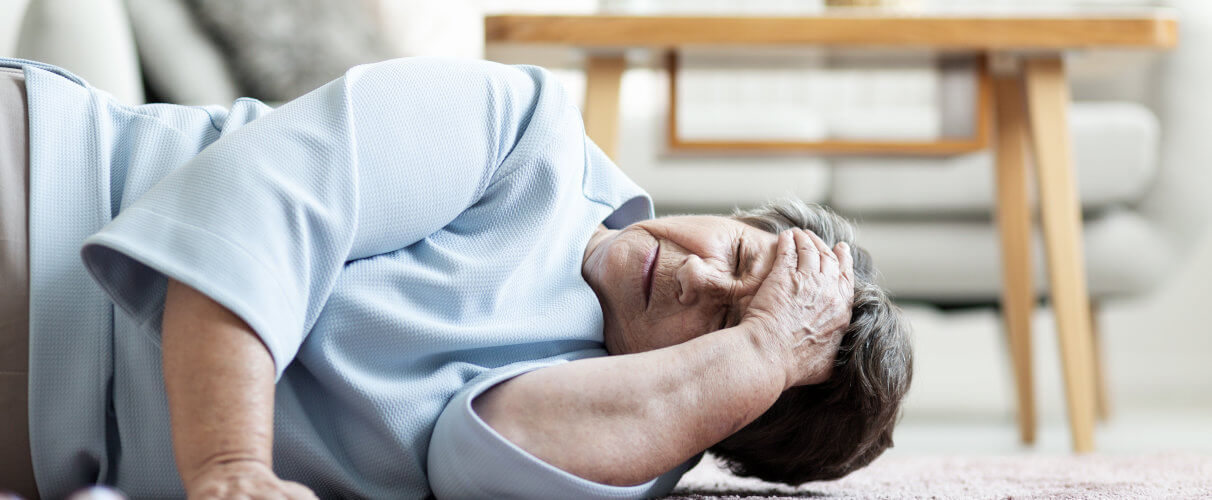
8 Ways To Reduce The Risk of Falls In The Home
A fall in the home could put you at risk of injury, especially if you are elderly or have weaker bones / joints (which tends to happen as we age). Research shows that almost 3 out of 4 falls occurs inside or close to the home, and 1 out of 5 falls can lead to serious injuries.
Fortunately there are some simple things you can do to reduce the risk of falls happening inside your home. Here are our top tips...
1.  Use a walking stick, walking frame or indoor rollator
Use a walking stick, walking frame or indoor rollator
A walking stick, walking frame or indoor rollator could be your best friend if you have reduced mobility. These mobility aids help you avoid falls by providing a firm grip with the floor while walking.
Using a walker will also reduce the pressure exerted on your knee and hip joints, which could be useful if you experience joint pain as a result of osteoarthritis for example.
You can use a walking stick, walker or rollator while outdoors as well, but its a good idea to have different ones that stay inside so you are not bringing mud or dust inside your home.
Some rollators and walking frames are specifically designed for indoor use and are narrower to fit through narrow doorways for example.
2. Install hand railings
Hand railings can come in handy, literally, in case you happen to miss a step, trip, or slip. You can have hand railings installed on your staircase so that you can hold on to them securely while climbing up and down.
You can also install railings or grab bars in your bathroom, especially next to the bathtub so that you can hold it while stepping out of a shower or bathtub.
3. Pay special attention to the lighting
Poor light is one of the most common reasons for people tripping or falling. Dim light in your rooms or corridors could prevent you from seeing objects lying around or the water spilled on the floor. It may also increase your risk of tripping over a rug for example.
Take a look around your house and see where the dark spots are, and consider getting an extra light or lamp installed so you can see clearly while walking around.
And one more thing…often we assume we know our house layout and so don't bother switching on the lights when we get up at night. But the combination of dark and being more wobbly after waking-up is a combination best avoided! So always switch on the light if you can!
4. Rearrange furniture
Your risk of falling depends a lot on how you arrange the furniture in your house. The more you keep the furniture out of your way while moving around, the safer it would be for you.
Rearrange furniture such that you have a clear path to walk through. Avoid placing any piece of furniture in the middle of the room.
Also, don't forget to tuck those extension cords under the couch and block any hazard that could cause you to trip.
This will allow you to move around freely without stumbling on the couch or hitting a table. It will also make it easier for you to perform your daily chores.
5. How about a non-slip mat?
The kitchen and bathroom are the two common places where the incidences of falls occur more frequently. The wet floor of the bathroom and the water or milk spilled on the kitchen floor can cause you to slip and fall.
It is possible to reduce these potential dangers by placing a non-slip mat in the kitchen, shower, and bathtub. The friction between the mat and the floor can help to keep you from slipping while stepping on these surfaces.
6. Don't trust the rugs
As you age you may find it more difficult to lift your foot while steeping on to a rug from the floor. Older people have a tendency to drag their feet across the floor rather than walking swiftly.. This possibly occurs due to the weakness of the muscles and bones or pain in the joints due to osteoarthritis.
The tendency to avoid lifting the foot while stepping on to a rug can increase your risk of tripping. Also, at times, you may not notice the rug and get your feet entangled into its sides. Sometimes, rugs can even slip on a hardwood floor, if they are not secured properly.
The best way to avoid tripping over rugs is to secure them down using non-skid tape. You can also get the worn and loose carpeting repaired to avoid tripping or getting your feet entangled into them.
7. Keeps things easily accessible
No one knows better than you the things you need more frequently. Whether it is your medicines, TV remote or the kitchen utensils,; keep them at places where you can reach easily.
Avoid placing items that you need frequently at a height so that you do not have to climb on a stool and risk falling off!
8. Choose shoes with good grip
Shoes that provide a good grip while walking can be a great accessory to have for avoiding falls.
The grip or friction provided by the soles of these boots can provide support and stop you slipping or sliding, giving you time to balance yourself or hold on to something for support.
There are lots of comfortable, supportive indoor shoe options to choose from, we like HomeyPed
Conclusion
Making your house fall-proof by adopting these measures could provide you with considerable freedom to move around. It will enable you to avoid falls, fractures, and injuries and help you enjoy a healthy and active life even during older age.
Other References:
- https://pubmed.ncbi.nlm.nih.gov/20122510/
- https://www.ncbi.nlm.nih.gov/pmc/articles/PMC3591732/
- https://pubmed.ncbi.nlm.nih.gov/15507060/


 Use a walking stick, walking frame or indoor rollator
Use a walking stick, walking frame or indoor rollator